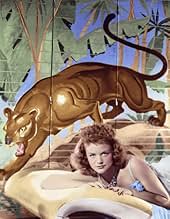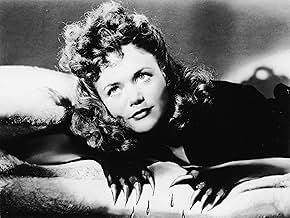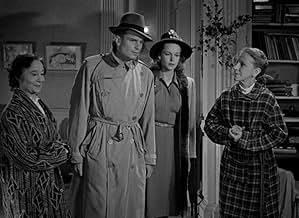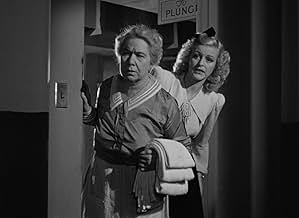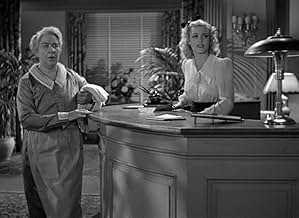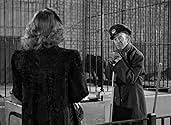IMDb RATING
7.2/10
28K
YOUR RATING
An American man marries a Serbian immigrant who fears that she will turn into the cat person of her homeland's fables if they are intimate together.An American man marries a Serbian immigrant who fears that she will turn into the cat person of her homeland's fables if they are intimate together.An American man marries a Serbian immigrant who fears that she will turn into the cat person of her homeland's fables if they are intimate together.
- Awards
- 2 wins & 3 nominations total
Henrietta Burnside
- Sue Ellen
- (uncredited)
Alec Craig
- Zookeeper
- (uncredited)
Eddie Dew
- Street Policeman
- (uncredited)
Elizabeth Dunne
- Mrs. Plunkett
- (uncredited)
Dynamite
- The Panther
- (uncredited)
Dot Farley
- Mrs. Agnew
- (uncredited)
Mary Halsey
- Blondie
- (uncredited)
Theresa Harris
- Minnie
- (uncredited)
Charles Jordan
- Bus Driver
- (uncredited)
Donald Kerr
- Taxi Driver
- (uncredited)
Connie Leon
- Neighbor Who Called Police
- (uncredited)
Murdock MacQuarrie
- Sheep Caretaker
- (uncredited)
Alan Napier
- Doc Carver
- (uncredited)
- Director
- Writer
- All cast & crew
- Production, box office & more at IMDbPro
Featured reviews
I have this theory about the horror films of Val Lewton. It is my contention that these movies caused a sea change in the content and tone of the movies of Alfred Hitchcock. The reason I say this is simple, really: Lewton is the only filmmaker I have ever caught Hitchcock cribbing scenes from. He did it twice. Once from The Seventh Victim (dir. by Mark Robson), which I swear to god provides the first half of the Shower Scene from Psycho. The second from Cat People, which provided the pet store scene in The Birds. This second scene is almost a shot for shot swipe. Both of these steals are evidence that Hitch knew and admired the Lewton movies. More than that, though, there is a change in the subtext of Hitchcock's thrillers after the Lewton movies. The movies he made before them were cut from the Fritz Lang mold of political thrillers. After the Lewton movies, Hitch's movies became more psychosexual in nature. Vertigo, for instance, could easily fit into Lewton's output.
Cat People is the first of the Lewton movies and sets the tone for them. It pretends to be about a McGuffin (serbian were -panthers), but is actually about something else (in this case, frigidity and repressed lesbianism). This represents a huge change in the evolution of the horror movie. Cat People is the first horror movie to explore these themes as central concerns rather than as sub-rosa undercurrents. It also pioneered the techniques of film noir (which as a genre didn't really exist yet). Cat People is strikingly stylized and its effect is of stranding the viewer in the middle of a darkened room with some dreadful beast circling just outside his sphere of perception. This has a hell of an impact--particularly if you have the good fortune to see this in a theater. I'm not going to claim that Cat People is one of the best horror movies ever made (it does have flaws), but it is one of the four most influential horror movies ever made (along with The Cabinet of Dr. Caligari, Psycho, and Night of the Living Dead). But unlike its brethren, its influence spreads corrosively through the entirety of cinema through both film noir and the films of Alfred Hitchcock. You would be hard pressed to find any film short of Citizen Kane or Rashomon that is nearly as influential.
Cat People is the first of the Lewton movies and sets the tone for them. It pretends to be about a McGuffin (serbian were -panthers), but is actually about something else (in this case, frigidity and repressed lesbianism). This represents a huge change in the evolution of the horror movie. Cat People is the first horror movie to explore these themes as central concerns rather than as sub-rosa undercurrents. It also pioneered the techniques of film noir (which as a genre didn't really exist yet). Cat People is strikingly stylized and its effect is of stranding the viewer in the middle of a darkened room with some dreadful beast circling just outside his sphere of perception. This has a hell of an impact--particularly if you have the good fortune to see this in a theater. I'm not going to claim that Cat People is one of the best horror movies ever made (it does have flaws), but it is one of the four most influential horror movies ever made (along with The Cabinet of Dr. Caligari, Psycho, and Night of the Living Dead). But unlike its brethren, its influence spreads corrosively through the entirety of cinema through both film noir and the films of Alfred Hitchcock. You would be hard pressed to find any film short of Citizen Kane or Rashomon that is nearly as influential.
Jacques Tourneur directed this Val Lewton production that stars Simone Simon as Irina Dubrovna, a Serbian immigrant working as a fashion artist in New York City who meets Oliver Reed(played by Kent Smith) at the zoo. They fall in love and get married, but run into trouble when she finds herself afraid of intimacy, since she believes the fables and legends of her homeland that indicate she is descended from a cursed line of Cat People, who turn murderous when aroused. He scoffs at this, but when his friend & co-worker Alice(played by Jane Randolph) is stalked by a cat-like creature, he begins to wonder. Meanwhile, Irina sees psychiatrist Dr. Louis Judd(played by Tom Conway) who has designs on Irina himself... Eerie and original film avoids monster movie clichés to create an effective atmosphere of dread. Quite intelligent as well, though requires patience, since it is decidedly different!
This film hits me on the most personal level of any film I've ever seen. This tale about a young, beautiful, Serbian immigrant named Irena, who marries a man named Oliver, but can't have sex with him because she believes she'll kill him, is a movie that speaks to me every time I watch it. I see so much of myself in the character of Irena, and I connect so much with her tortured psyche. The way she is afraid of hurting those she cares about, the way no one can understand her, and the way she's her own other worldly being are aspects that I can identify with, and make me look at Irena as a kindred spirit for me. But aside from relating to the lead character, I also adore Jacque Tourneur's artistic direction, the story, the lighting, the music, the dialogue, and the overall poetic, and darkly romantic feel to this movie. This film is a true work of art, I've watched it millions of times, and I'm still not done with it. Val Lewton, I love you!
At the zoo, Oliver Reed (Kent Smith) sees the mysterious Irena Dubrovna (Simone Simon), who is sketching a black panther. He's intrigued by her--it seems to be love at first sight--and is surprised when she invites him into her apartment for a cup of tea. While in her apartment, he sees an odd statue of a man on horseback, holding a sword-skewered cat high in the air. Dubrovna tells him of her native Serbia, and the legend of unchristian "cat people" who were driven into the mountains. Dubrovna's behavior becomes increasingly odd, and animals often react strangely to her. Could she have something to do with the legend of the cat people?
This was director Jacques Tourneur and producer Val Lewton's first horror/thriller film together (they were to do two others together, I Walked With A Zombie (1943) and The Leopard Man (1943)), and for my money, this is the best of the three. Lewton was famous for understated, atmospheric horror that suggested more than it showed, a style that is also evident in his later collaborations with director Robert Wise (who went on to direct the infamous The Haunting (1963), which is often thought to be a pinnacle of this more "suggestive" style, although it's not a particular favorite of mine).
So what does this mean? Well, a lot of younger horror fans, for whom the oldest film that they are really familiar with in the genre is something like The Texas Chainsaw Massacre (1974) or an even more recent film, might be reluctant to call Cat People a horror film. It is "talky", doesn't contain any graphic violence, and we don't even see a horror creature/villain until just a glimpse near the very end of the film. But it is horror--the talking is centered on a captivating supernatural "myth", there are a lot of creepy, well-photographed scenes laden with heavy shadows, there are a couple exquisite chase/suspense scenes, and there is a lot of complex, dark psychological interaction.
The psychological tension is really the focus, as Lewton and Tourneur's films together are moral parables that function more as a metaphor for horror (rather than the more common flipside, where the horror is more prominent and might be a metaphor for some other kind of philosophical point). In this case, the moral and social situations are varied and complex, but are all focused on romantic relationships, ranging from quick actions taken due to lust, to emotional distancing, adultery and abuse of power. The more one watches the film, the more one is likely to get out of the subtextual messages. They remain more subtextual than they might in modern cinema because of content restrictions imposed by studios in this era (although of course those were a reaction to prevalent cultural attitudes at the time). But in retrospect, the buried nature of the themes is a benefit, at least in this case.
Occasionally, the horrific aspect of these types of films can be too understated, so that they simply become realist dramas. That's not the case here. This is a film that is rewarding on many levels.
A 9 out of 10 from me.
This was director Jacques Tourneur and producer Val Lewton's first horror/thriller film together (they were to do two others together, I Walked With A Zombie (1943) and The Leopard Man (1943)), and for my money, this is the best of the three. Lewton was famous for understated, atmospheric horror that suggested more than it showed, a style that is also evident in his later collaborations with director Robert Wise (who went on to direct the infamous The Haunting (1963), which is often thought to be a pinnacle of this more "suggestive" style, although it's not a particular favorite of mine).
So what does this mean? Well, a lot of younger horror fans, for whom the oldest film that they are really familiar with in the genre is something like The Texas Chainsaw Massacre (1974) or an even more recent film, might be reluctant to call Cat People a horror film. It is "talky", doesn't contain any graphic violence, and we don't even see a horror creature/villain until just a glimpse near the very end of the film. But it is horror--the talking is centered on a captivating supernatural "myth", there are a lot of creepy, well-photographed scenes laden with heavy shadows, there are a couple exquisite chase/suspense scenes, and there is a lot of complex, dark psychological interaction.
The psychological tension is really the focus, as Lewton and Tourneur's films together are moral parables that function more as a metaphor for horror (rather than the more common flipside, where the horror is more prominent and might be a metaphor for some other kind of philosophical point). In this case, the moral and social situations are varied and complex, but are all focused on romantic relationships, ranging from quick actions taken due to lust, to emotional distancing, adultery and abuse of power. The more one watches the film, the more one is likely to get out of the subtextual messages. They remain more subtextual than they might in modern cinema because of content restrictions imposed by studios in this era (although of course those were a reaction to prevalent cultural attitudes at the time). But in retrospect, the buried nature of the themes is a benefit, at least in this case.
Occasionally, the horrific aspect of these types of films can be too understated, so that they simply become realist dramas. That's not the case here. This is a film that is rewarding on many levels.
A 9 out of 10 from me.
'Cat People' was the first collaboration between director Jacques Tourneur ('Curse Of The Demon') and producer Val Lewton, and is still one of their greatest achievements, and one of the most influential horror movies ever made. It's arguably the best horror movie made between the Universal classics of the 1930s and the beginning of Hammer studios in the 1950s. So many subsequent film makers from Hitchcock on down have been influenced by this movie and yet it rarely gets the respect it deserves. 'Cat People' pretends to be a monster movie but is really something more complex, and relies on atmosphere and suspense rather than explicit shocks or gore (there is virtually none of the latter). Fans of Hitchcock and film noir will probably appreciate it more than hardcore gorehounds. Simone Simon is very well cast as the mysterious and troubled Irena and the rest of the cast range from adequate to very good. The acting is probably one of the weakest links in the film but not enough to spoil your enjoyment (I think 1940s acting is an acquired taste and I can see how a modern viewer who expects more realistic and natural performances could sometimes find them a bit hard to swallow). 'Cat People' is a horror classic and is highly recommended to anyone interested in the genre.
Did you know
- TriviaThe horror movie technique of slowly building tension to a jarring shock which turns out to be something completely harmless and benign became known as a "Lewton bus" after a famous scene in this movie created by producer Val Lewton. The technique is also referred to as a "cat scare," as off-screen noises are often revealed to be a startled harmless cat.
- GoofsWhen Irena does not show up at her apartment when Dr. Judd, Oliver, and Alice are waiting for her, they leave. Dr. Judd hides his cane in the apartment to give him an excuse to borrow Oliver's key and go back in for it. Afterward, he leaves the door unlocked so that he can sneak back in, something that is hidden from Oliver and Alice. Yet, after Oliver and Alice are threatened in the office, they call the apartment to warn Dr. Judd that Irena is definitely dangerous and that he should leave.
- Quotes
Irena Dubrovna: I like the dark. It's friendly.
- Crazy credits[From the opening credits] "Even as fog continues to lie in the valleys, so does ancient sin cling to the low places, the depression sin the world consciousness." - "The Anatomy of Atavism" - Dr. Louis Judd
- ConnectionsFeatured in Draculeena Presents: Cat People (1960)
Details
Box office
- Budget
- $134,000 (estimated)
- Runtime
- 1h 13m(73 min)
- Color
- Aspect ratio
- 1.37 : 1
Contribute to this page
Suggest an edit or add missing content



